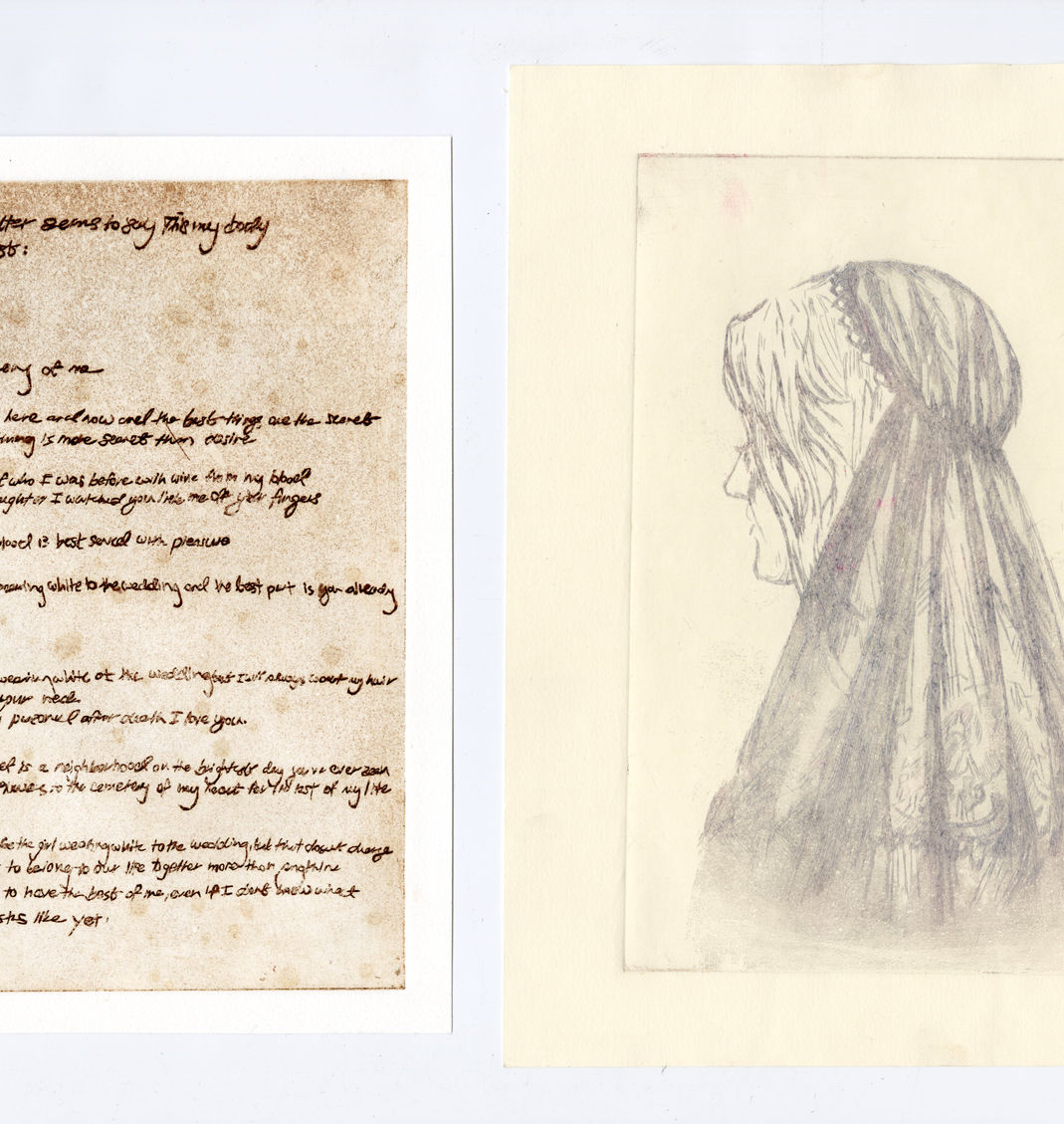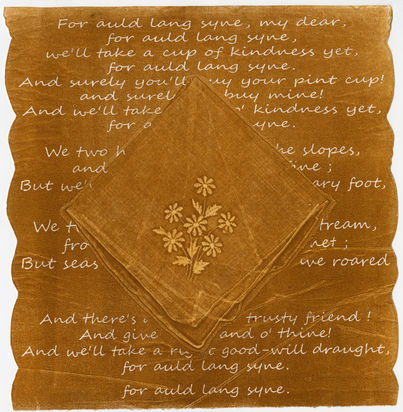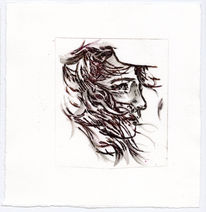
MONOTYPE
A print is more than just one thing, it's all the things that happen before and after on the slab, plate, press bed, and curation table. Creating a variable series highlights the effort of the edition and reveals a silent partner that artists through the labor of planning, registering, and exact method are always working alongside and can never leave behind,
Allowing the audience to see the process of thinking through prints allows for meditations on things both precious and clandestine, fleeting and archived, past and universally present both in reality and the ghosts they leave behind that we all share.
To balance the highly variable spread of each series, I choose to ground each series with a companion, text and the written word. My exploration of creative writing and monotype began in late 2021. My passion for literature, history, and story is expressed most clearly in my monotype practice and allows nuanced interpretation of history and the role others play in that story. Beginning with the practice of letter writing, my monotypes are heavily grounded in melancholy-tinged nostalgia for the ghosts of things held dear both past and present.
Claire Schmalzried, 3rd Stair to the 2nd, monoprint, 10.5 x 10.5 in., 2022
collaborative effort with Austin Mathew Dreyer
STIMULANTS
As I wrapped up my time at UNT as an undergrad, I experimented with refined techniques on the laser cutters found in the CVAD digital fabrication lab. Pushing the boundaries of exactness when it came to paper and ink., Stimulants is a monoprint series where I took layers of varying transparencies, number, and color on BFK to find the exact settings for "taking away" a layer to reveal the possibilities for new colors, gradients, and tones along with setting adjustments to allow for more efficient time and energy output.
The results were fascinating even with a simple line weight-based pattern taken from something I owed much credit to, Zero Sugar Monster energy drinks. I found humor in highlighting something I relied on and appreciated but found others often overlooked, and that included the irony of a health-conscious energy drink.
I drink Celsius now which I find even funnier. Caffeine is caffeine no matter if the can is cool and looks like Victorian wallpaper.
Claire Schmalzried, Stimualnts, laser etching monotype series, 11 x 15 in., 2022
NO LOVERS,
NO MOURNERS,
NO FUNERALS.
Love never dies despite the different versions of ourselves doing it often and dramatically. It is no coincidence the objects associated with both look strikingly similar. To love is to share grief. No Lovers, No Mourners, No Funerals is a multiple plate color intaglio series incorporating plates showing a bride, bridal bouquet ribbon, lovers eyes, victorian mourning jewelry, and my first piece of writing to ever make it into a print, a letter.
No Lovers, No Mourners, No Funerals explores a promise I tend to keep in my personal life that's a way to say it's not going to fail and that there will be no funeral to attend. Despite history being littered with lovers and affairs very much tragically dead, believing in love may one day be able to result differently, to rewrite history is something I think is very much possible. It was always more than adoring someone, that's not how I love, it's about promising someone there won't ever be a funeral just headstones for the occasional empty casket.
Lov·ers Eye
Noun
-
A small palm-sized painted miniature set usually in a precious metal frame with varying levels of ornamentation to be worn and coveted by a pair of lovers.
-
Commonly set in brooches, necklaces, and mementos. To show a secret affair without a direct confession
-
Each eye is unique with the depicted and the artist remaining widely anonymous. They articulate the essence of portraiture: the act of looking at you, the ability of a painting to hold you in its grip.
-
adoring, longing, and lusty to penetrating and eerily watchful.
Mourn·ing Jew·el·ry
/ˈmôrniNG/ /ˈjü-əl-rē/
Noun
-
Mementos featuring a tribute to a deceased subject, commonly with an inscription, their initials, an eternal knot, a lock of hair, a cameo, or a silhouette.
-
brooches, hair pins, tie pins, memorium rings, and lockets.
-
Common materials included jet, onyx, pearls, dark tortoiseshell, black enamel, bog oak, vulcanite, and gutta-percha.
-
Jewelry which contained locks of a loved one’s hair was particularly popular during the Victorian era. The Victorians believed that hair had a sacred quality because it contained something of the essence of the person. And because it was somewhat imperishable, The hair would be braided, plated, and woven to be admired.
Claire Schmalzried, No Lovers, No Mourners, No Funerals, etching and monotype series, 4 x 4 - 9 x 12in., 2022
"The issue of women in the arts lives and dies on the hill of, what is the need for female artists, when the women in art already exist?
The paradox of women adding eminence to the work and study of art, while being its source weakens it, begs the question, why does the male depiction of the female inherently create greatness over the female depiction of herself, to which she possesses more intimate knowledge and far greater access?
With this repeating, seemingly inconsistent, set of contradictions the answer is seen in man depicting something feminine he justifies it has reason. The male deals in the issue but is untainted: He's the dealer that does not take the hit of the original distributor or carry the stigma of the addict. The real issue is not women can’t be great artists because they are women, but because they aren't male versions of women.
Women lost to the ultimate power grab, not just of exclusion, but of appropriation. Conquered and rendered flat on the canvas, the great women artist is outshone by the multitudes of her genders’ appropriated image."
Cam·eo
/ˈka-mē-ˌō/
Noun
-
a small scene or figure carved in relief. having two different colored layers, with the figures carved in one layer so that they are raised on a background of the other.
-
This modern Italian word, meaning "to engrave", is thought to have come from the ancient Arabic word "khamea", meaning "amulet".The first cameos were found in the soft pink of seashells but came to include semi-precious gems. (commonly agate, onyx, or sardonyx).
-
Brief literary or film piece that brings into delicate or sharp relief the character, place, or event
-
A theatrical role where the actor plays themselves for a brief scene
Claire Schmalzried, Cameos, lithogrpahy , ~ 9x 12 in. , 2022
CAMEO SERIES
In the myth of Medusa, the hero must use only the flat reflected image to navigate, and as such, the male artist uses the canvas and distorted image of women to communicate and justify higher thought and ideas of genius and greatness. The essence of femininity and the women artist has never fully been found among the multitudes of her genders’ appropriated image which leads me to propose what would it mean to make depictions of women from the female gaze and what would it mean to reclaim our own archetypes from history?
The history of the cameo is unique in that it's an art form dominated by images of women (even the men (greek heroes) are feminized) but also then in turn owned by women in that they were used to promote a women’s beauty, sexuality, and history but all of this is still done from the male gaze
The history of the cameo as we think of it in jewelry and not just as a term related to all small carvings, began as what is recognizable as an early photograph. Their popularization began as souvenirs to commemorate trips to historic cities in the Mediterranean and were the modern “snapshot” of landscapes and scenic pastoral images. Departing from these rare early examples we come into women seen in side profile, the muses, Rebecca at the Well, and the Greek goddesses. n short, the cameo is a study of the quintessential anonymous woman in multitudes.
In a series of 14 paper plate lithograph monoprints, the classic female archetype exists including other interpretations together as more than a linear progression based on time but as a complex web of transition of femininity through the female gaze
Prints Include: Childhood, The Young Woman, The Maiden, Sisterhood, Whisperer, Muse, Self Portrait, The Lovers, The Bride, Pregnancy, Mothernature, Motherhood, Grandmother, and the Wander
ALEWIVES TALE
Alewives' Tale centers around the idea of comparing the concept of the fleeting chance encounter with objects to that of nature being able to produce the same experience through the transience of spontaneous species-specific catastrophic events observed by an individual bystander. As quickly as they appear the multitudes of bodies disappear yet the ghosts still linger on the shore and in memory with a simple knowing they will appear again.
Using the common chatelaine object of the reticulated fish common in Victorian jewelry as a hidden container and the phenomena of alewife die off in the great lakes. Alewives Tale, using techniques of woodblock monotype, lithography, and laser etching, is a ghost print paired with a poem told from the perspective of the fictional chatelaine owner.
The fish appear alive and others dead within a limited color palette of greys, graphites, silvers and sand tones as ghosts, outlines, metallic recreations, and shimmering glittering waves to show that while visually different are the same thing recreated again and again and can be experienced similarly without the need for a constructed or expected timeframe.
To be seen once is to wonder when and how to be seen again.
Ar·tic·u·lat·ed Fish
/’ärˈtikyəˌlādəd/ /fiSH/
Noun
-
A common form of functional jewelry that involves connecting joints and an internal hinged mechanism to create a moving metal body around a container for small trinkets. Form is most often a fish.
-
having two or more sections connected by a flexible joint./(of an idea or feeling) expressed; put into words.
-
Can be found attached to larger objects of functional adornment such as the Chatelaine
-
Chat·e·laine (\SHAT-uh-layn\) N:
-
a set of short chains attached to a woman's belt clasp, used for carrying keys or other items.
-
the mistress of a household (to whom the keys belong)
-
-
Claire Schmalzried, Alewives Tale, lithograph, etching, and monotype , 9 x 12 in., 2022
THAT WHICH THE SEA BREAKS AGAISNT
The subject matter of this series returns to my more modern content of transient objects but in the form of specifically beach distress. That Which The Sea Breaks Against explores the contrasting idea of nature/natural to fabrication/ objects. Objects are not nature but must exist within it. Humans create objects perpetually that in turn become a veil that alters our own perception of the natural world.
Referencing the location of a shoreline as a window to the world of the natural and artificial coming together just like the land and sea and the idea of nature, just like humans, collecting objects, That Which The Sea Breaks Against speaks to the layering of objects each with unique characteristics that speak to an existence beyond what we see between a certain now and softly echoing past. The torn wings of monarch butterflies, the discarded ends of smoked cigarettes, vintage clothespins, and a pair of broken hair combs paint a littered emotional story at ones feet of a girlhood mourned from a half-realized adulthood frozen on that which the sea breaks against.
Girlhood is feeling sentimental for dead things from the past.




Claire Schmalzried, That Which The Sea Breaks Against, stencil monotype 5 x 7 - 11 x 15in., 2022
.jpg)
MODELO CANS
The subject matter of this series returns to my more modern content of transient objects but in the form of a singular crushed beer can. Objects are not nature but must exist within it. Humans create objects perpetually that in turn become a veil that alters our perception of the natural world even if it's a simple piece of parking lot trash.
The alcohol and tobacco industry has a long history of excellent commercial advertising and marketing and that even something so casually discarded (hopefully recycled) has character. The proximity to Fry Street bars made the walk from my apartment and the CVAD parking lot a garden of such trash that bloomed all year round. Starbucks cups, hot pink mini lighters, tampon wrappers, insect wings, condom wrappers, Miller Lite cans crushed under tires, and discarded vapes thrown in the grass stood out so brightly even when they weren't shiny and new anymore.
Something about this Modelo can stood out to be the best of all the trash I ran across and now I catch myself scanning every parking lot and new place for the shinest discarded things.
Claire Schmalzried, Gold Dark Days, monotype series, 11 x 7.5 - 11 x 15 in., 2022























































